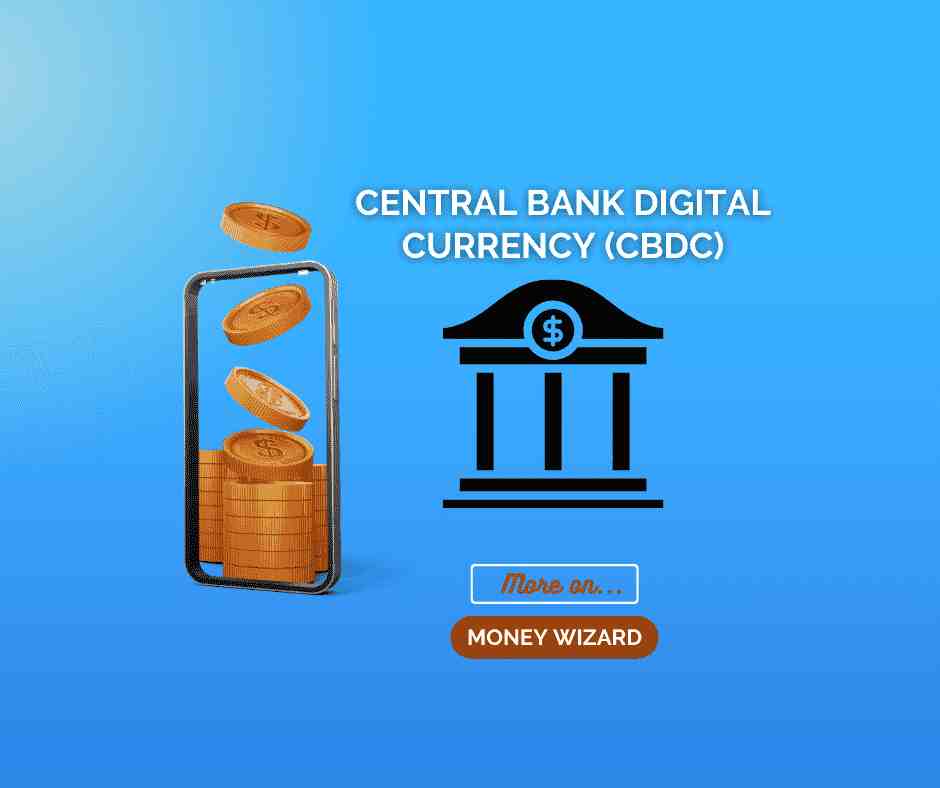
Introduction
With the emergence of digital currencies, the financial environment has undergone a striking change recently. While cryptocurrencies like Bitcoin and Ethereum have drawn a lot of attention, the rise of Central Bank Digital Currencies (CBDCs) has been another ground-breaking development. CBDCs are digital representations of a nation’s fiat currency that are issued and governed by that nation’s central bank.
What is CBDC?
Central Bank Digital Currency is what CBDC stands for. It refers to a nation’s fiat money, such as the US dollar, Euro, or Chinese yuan, that is issued and governed by the central bank but exists only in digital form. CBDCs are made and controlled by central banks.
CBDCs are digital versions of conventional currency. In order to offer a safe, effective, and inclusive payment method and store of value, they want to capitalize on the advantages of digital technology. Central banks seek to modernize their payment systems, increase financial inclusion, and meet the changing demands of digital economies through the introduction of a CBDC.
Difference between CBDC and Cryptocurrency:
Cryptocurrencies and Central Bank Digital Currencies (CBDCs) are both digital forms of money, yet they differ significantly.
Centralization vs. decentralization:
While cryptocurrencies are primarily decentralized digital currencies functioning on blockchain technology without a central authority, CBDCs are centralized digital currencies that are issued and regulated by a central bank.
Issuing Authority:
Central banks, which are government entities in charge of monetary policy and financial stability, are the organizations that issue and regulate CBDCs. Cryptocurrencies are primarily produced by individuals or organizations through the mining process or initial coin offerings (ICOs).
Legal Tender:
CBDCs are recognized as legal tender and have the same status as physical currency in the respective country, meaning they must be accepted for payments. Cryptocurrencies are generally not accepted as legal money, and whether they are accepted in a transaction depends on the parties involved.
Backing:
CBDCs are linked to the nation’s fiat currency and are backed by the central bank’s reserves. The value of cryptocurrencies depends on market demand and perceived utility; they have no intrinsic value or physical support.
Governance and Regulation:
The central bank and other government agencies regulate and monitor CBDCs. On the other hand, cryptocurrency operations are decentralized and frequently independent of any one regulatory authority. The laws governing cryptocurrencies differ considerably between different countries.
Scalability and Transaction Speed:
CBDCs have been designed to facilitate scalable and instant transactions, usually utilizing pre-existing payment infrastructure. Due to blockchain technology’s network constraints and consensus processes, cryptocurrencies may experience transaction speed and scalability issues.
Purpose and Objectives:
CBDCs are primarily aimed at improving financial inclusion, enhancing payment systems, and advancing monetary policy goals. Cryptocurrencies emerged with the vision of providing an alternative form of currency and challenging traditional financial systems.
Privacy:
The safety and privacy standards for CBDCs are similar to those that apply to conventional banking transactions. Cryptocurrencies are designed to provide more privacy and anonymity.
Advantages of CBDCs
- Financial Inclusion: By granting unbanked and underbanked communities access to financial services, CBDCs have the potential to foster financial inclusion. With CBDCs, people can participate in the formal financial system and have a digital wallet even if they don’t have a traditional bank account.
- Efficiency and Cost Reduction: CBDCs can improve the effectiveness of payment systems, resulting in faster and more convenient transactions along with cost reduction. They can lower the costs of managing currency, maintaining physical infrastructure, and using intermediaries, which could result in cost savings for people, companies, and governments.
- Payment System Innovation: By offering a secure and dependable digital currency base, CBDCs can promote innovation in payment systems. It may promote the creation of innovative payment methods like smart contracts and programmable money, which would enhance efficiency and open up new business prospects.
- Monetary Policy Instrument: CBDCs can provide central banks with extra monetary policy instruments. The transparency and traceability of CBDC transactions can support the analysis of consumer behavior, the tracking of economic activity, and the implementation of targeted interventions as needed.
- Combat Illegal Activities: CBDCs can aid in the fight against illegal activities, including fraud and money laundering. It could be hard to engage in unlawful financial activity due to the openness and traceability elements of CBDC transactions.
- Financial Stability: CBDCs can help make the financial system more secure. Utilizing CBDCs may reduce the need for intermediaries, improve the robustness of payment systems, and possibly minimize systemic risks.
- Cross-Border Payments: CBDCs can speed up and simplify cross-border payments, making them more affordable, quick, and effective. CBDCs can cut transaction costs, do away with the need to use multiple intermediaries, and foster stronger international financial relationships.
- Trust and Confidence: Users may feel a certain amount of trust and confidence in CBDCs issued by central banks. As a result of the support and stability offered by the central bank, CBDCs may be more quickly embraced and accepted by people and enterprises.
- Enhanced Data Analytics: CBDCs can offer safe, regulated access to transaction data. In order to make more informed policy decisions, central banks can use this data to acquire insights into consumer behaviour, economic trends, and financial threats.
Types of CBDCs :
Central banks from around the world are exploring a variety of Central Bank Digital Currencies (CBDCs). The purpose, accessibility, and design of these models can all vary. The following are some of the most common CBDCs:
Wholesale CBDC:
This kind of CBDC is only allowed in wholesale or interbank transactions and is primarily used by financial organizations. Wholesale CBDCs can speed up and decrease the cost of settlement procedures between banks and other financial institutions.
Retail CBDC:
Retail CBDCs are intended for usage by the general public and allow the direct holding and exchange of digital currency by people and enterprises. Similar to cash or conventional bank accounts, they can be accessed using digital wallets and used for a variety of routine transactions.
Account-Based CBDC:
Account-based CBDCs include having a direct bank account with the central bank for both individuals and enterprises. As a result, there is a high level of security and trust in the currency and users have a direct claim on the central bank. Account-based CBDCs provide a more centralized approach to digital currency.
Token-Based CBDC:
Token-based CBDCs issue digital tokens that serve as a representation of the virtual currency. Peer-to-peer transfers and storage of these tokens are both possible in digital wallets. Token-based CBDCs may enable offline transactions and offer enhanced anonymity.
Hybrid CBDC:
Wholesale and retail CBDC components are combined to create hybrid CBDCs. They offer a wide range of features and are used by both financial institutions and the general public. The objective of hybrid CBDCs is to strike a balance between security, efficiency, and accessibility.
Global CBDC Initiatives:
Central Bank Digital Currencies (CBDCs) have attracted a lot of interest and momentum worldwide, and several nations are now considering or launching CBDC programs.
The Bahamas (Sand Dollar):
The Bahamas became the first nation to fully implement a CBDC countrywide when the Central Bank of The Bahamas introduced the Sand Dollar. The Sand Dollar is a digital rendition of the Bahamian dollar designed to increase financial inclusion and minimize the archipelago’s dependency on hard currency.
China (Digital Yuan):
China has made significant strides in creating and testing its digital currency, the Digital Currency Electronic Payment (DCEP), also called the digital yuan. Because of extensive testing in many cities, users can now perform digital yuan transactions using mobile apps and digital wallets.
Sweden (e-Krona):
In response to the nation’s declining use of cash, Sweden’s central bank, the Riksbank, has been examining the viability of an electronic version of the krona. The project intends to give all citizens access to a safe and dependable payment method.
European Union (Digital Euro):
The European Central Bank (ECB) is actively studying and assessing the prospective implementation of a digital euro in the European Union. To better understand the advantages and disadvantages of a digital euro, the ECB has begun an investigative phase and has consulted with and surveyed the public.
United States (Digital Dollar):
There have been numerous suggestions and talks around the idea of a digital dollar in the United States. Research is being undertaken, and support for the development of a U.S. CBDC has been promoted by The Digital Dollar Project, a collaboration between Accenture and the Digital Dollar Foundation.
Japan:
The Bank of Japan has started studying and testing CBDCs. To investigate the technical and legal ramifications of CBDCs and their likely effects on the Japanese economy, it has formed a research team.
Singapore:
The Monetary Authority of Singapore (MAS) examined the potential advantages and challenges of CBDCs in depth. The MAS has conducted cross-border CBDC trials in conjunction with other central banks, notably Canada.
United Kingdom:
Central Bank Digital Currency Research To examine the potential for adopting CBDC in the UK, the Bank of England formed a research project known as the CBDC Taskforce. The task force’s goal is to evaluate a digital currency’s likely benefits, challenges, and practical ramifications.
Indian Digital Rupee (e₹):
The Reserve Bank of India will issue the Digital Rupee, also known as eINR or E-Rupee, as a central bank digital currency. It is a tokenized digital version of the Indian Rupee.
In October 2020, the Reserve Bank established an Internal Working Group (WG) to carry out research on the best possible design and execution architecture for implementing CBDCs in India. This was carried out in keeping with the global developments in the field of CBDC.
A High-Level Inter-Ministerial Committee was previously established in November 2017 under the leadership of the Secretary, of the Department of Economic Affairs (DEA), Ministry of Finance, Government of India (GoI), to review the policy and legal framework for the regulation of virtual / cryptocurrencies and recommend appropriate measures to address issues arising from their use. The committee has advocated the use of CBDCs in India as a digital form of sovereign money.
Future Outlook of CBDCs:
The Central Bank Digital Currencies’ (CBDCs’) future view is dynamic and full of opportunities. Several potential changes and trends could influence CBDCs’ future.
- Increased Adoption: Global usage of digital currencies is expected to grow as more central banks explore and expand their CBDC programs. CBDCs can coexist peacefully with conventional fiat currencies and other forms of electronic payment.
- Financial inclusion: CBDCs’ promotion of financial inclusion is one of their main objectives. CBDCs can give underbanked and unbanked communities access to financial services, enabling them to take part in the established financial system. CBDCs assist in narrowing the accessibility and convenience gaps between people and financial services.
- Evolution of Payment Systems: CBDCs have the potential to significantly alter payment infrastructure. Peer-to-peer transactions, international payments, and automated transactions based on smart contracts may all witness improvements with the emergence of digital currencies. Payment systems that are more effective, secure, and affordable may result from this evolution.
- Collaboration and Interoperability: For smooth cross-border transactions, interoperability between CBDCs and other digital currencies is essential. The creation of interoperability standards, protocols, and frameworks by central banks and financial institutions may make it possible for various CBDCs and digital payment systems to operate together in a safe and effective manner.
- Technology Advancements: CBDCs have the potential to gain from advances in technology. Blockchain and distributed ledger technology will keep evolving, providing CBDC implementations with better scalability, privacy, and security features. CBDC frameworks may incorporate new technologies like programmable money and tokenization, enabling more sophisticated functionalities.
- Regulatory Frameworks: As CBDCs evolve, the regulatory structures will need to change to deal with challenges with cybersecurity, anti-money laundering (AML), consumer protection, and privacy. The proper and safe use of CBDCs will be ensured by clear rules and regulations, which will also serve to reduce any risks and unlawful conduct.
- Global Collaboration: The future of CBDCs will be strongly influenced by international collaboration and cooperation. To build uniform norms and frameworks for CBDCs, central banks will collaborate through forums and organizations like the Bank for International Settlements (BIS) and the International Monetary Fund (IMF).







